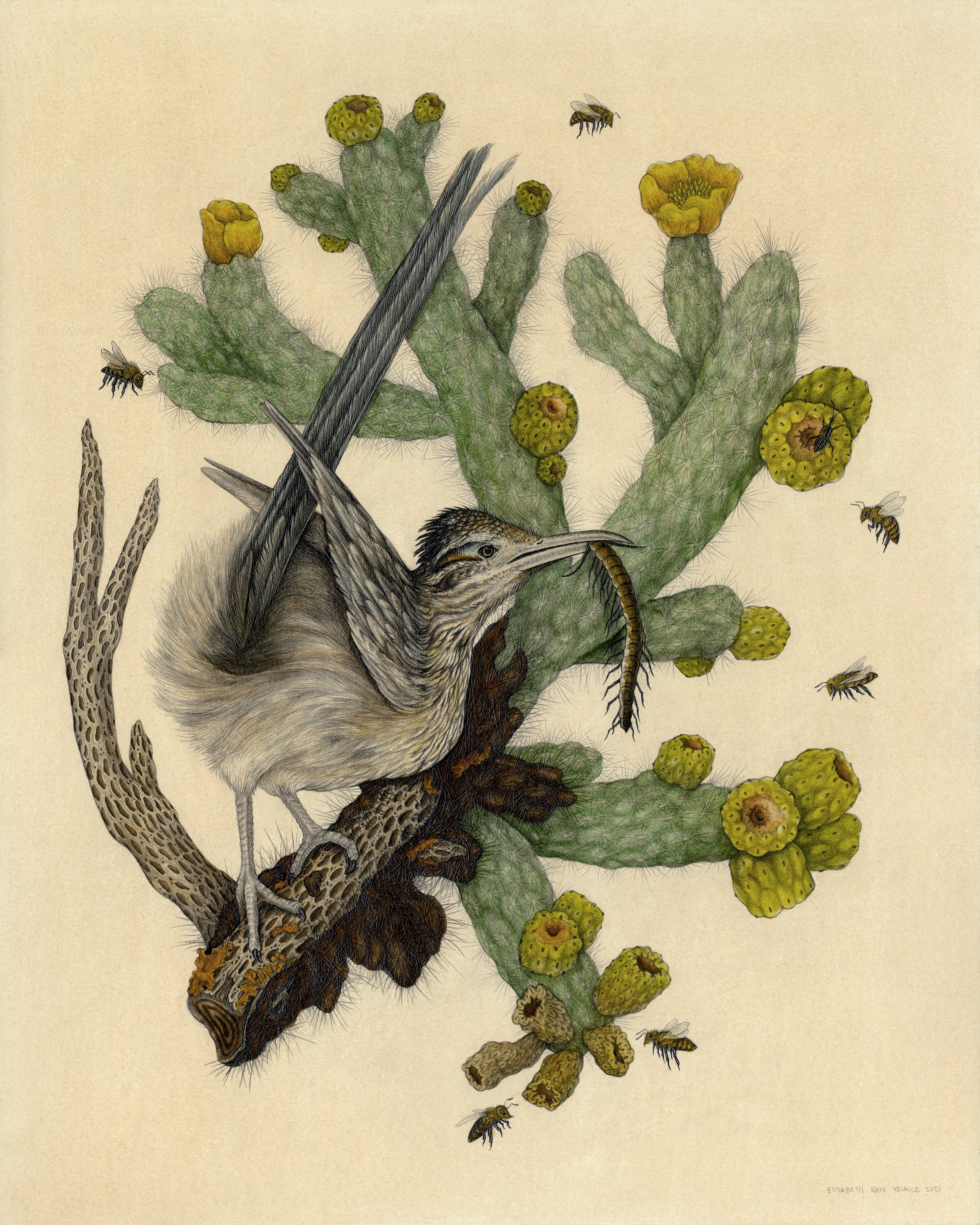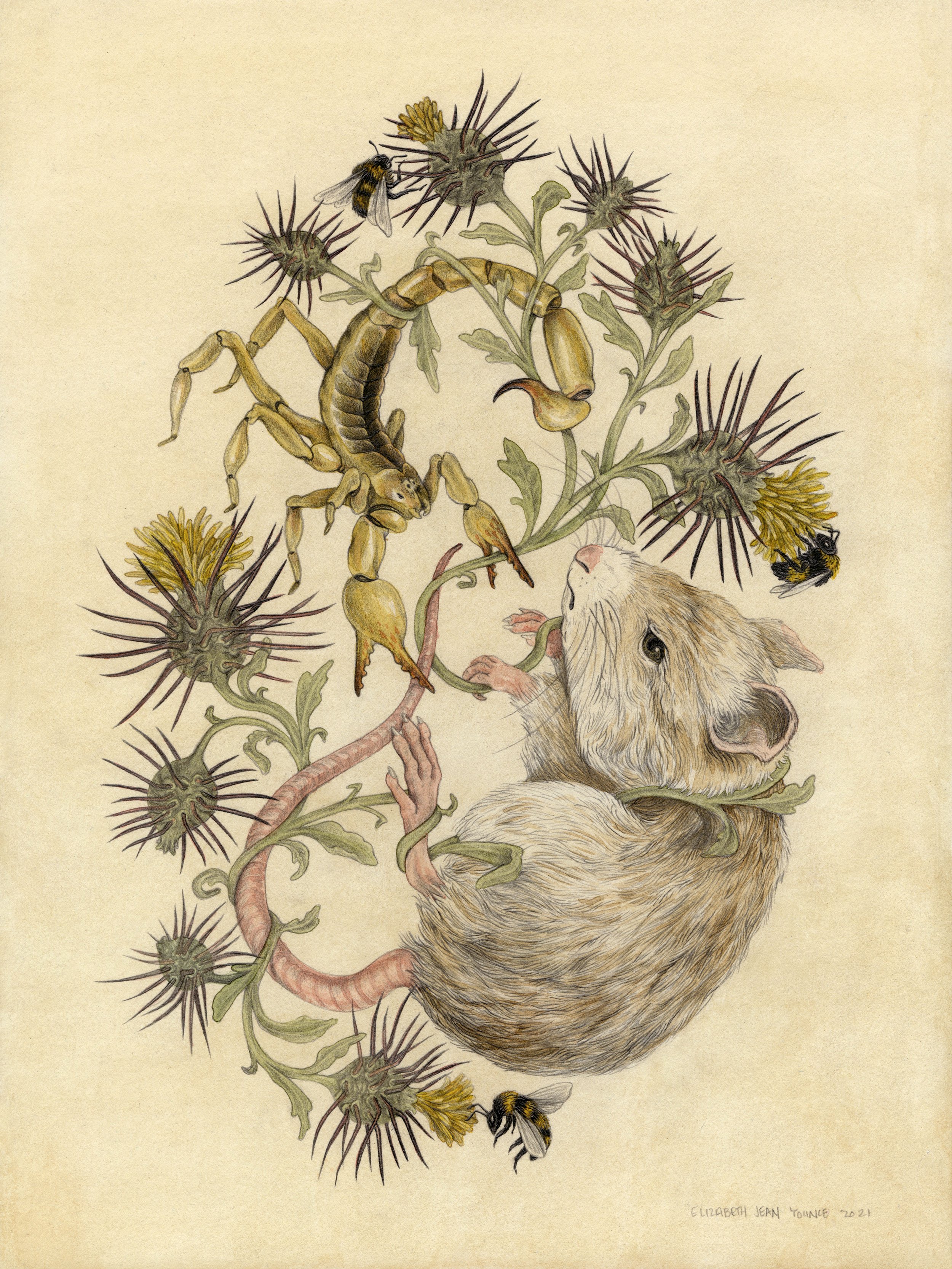The Withering
Solo Exhibition at Talon Gallery, Portland OR, Spring 2021
Limulus polyphemus (Atlantic horseshoe crab and their eggs), Calidris canutus (red knot), and Busycotypus canaliculatus (channeled whelk eggs)
Graphite + Watercolor | 18 x 24”, framed to 21 ¾ x 27 ¾” | 2021
Bled Dry
Did you know that Horseshoe Crabs have been overfished for their role in the Biomedical and Fishing Industries? Their blue, copper-based blood, clots on contact with bacteria, making it a useful tool for testing sanitation in vaccines (including the COVID-19 vaccine) and other medical tools. For this purpose they are fished, bled of 1/3 of their blood, then thrown back into the ocean. These companies say the Horseshoe Crabs survive the ordeal but, many do not. They are also fished to be used as bait in Eel and Whelk fisheries. Red Knots make an incredible migration from the Southern most tip of Argentina all the way to the Canadian Arctic. They stop about halfway in the Delaware Bay, the Horseshoe Crab’s largest breeding ground, and the birds feast on their eggs. Since Horseshoe Crab populations have been significantly decreasing over the past few decades, the Red Knots have suffered as well. Birders have noticed that the birds are not traveling as far north to their breeding grounds as they used to and their populations are also suffering as a result.
Did you know that Horseshoe Crabs aren’t even Crabs or Crustaceans at all? They’re actually Arthropods.
SHOP
dwelling in grief
The Sage Grouse only feeds on Sagebrush, yet invasive Cheatgrass is nearly wiping out the native flora. Not only does it grow more rapidly but it also burns more frequently, hotter, faster, and is also able to recover from fire faster. The spread of Cheatgrass is an obvious threat to our beautiful Grouse but also can have devastating effects on our insects, which could impact our ecosystem from a macro scale. This beetle, from the Scarab family, is widespread but potentially threatened by habitat and native plant loss. Its larvae also feed on endemic native plants which are being overtaken by invasive ones. These species ranges overlap in the Sagebrush steppe.
shop prints (original sold out)
Centrocercus urophasianus (greater sage grouse), Paracotalpa granicollisis (hairy scarab beetle), and (invasive) Bromus tectorum (cheatgrass)
Graphite + Watercolor | 16 x 20”, framed to 19 ¾ x 23 ¾” | 2021
Geococcyx californianus (greater roadrunner), Opuntia bigelovii (teddy-bear cholla cactus), and (invasive) Apis mellifera scutellata Lepeletier (Africanized honey bee)
Graphite + Watercolor | 16 x 20”, framed to 19 ¾ x 23 ¾” | 2021
if only it stayed this way
The greater roadrunner, teddy-bear cholla cactus, and Africanized honey bees ranges overlap in the Saguaro National Park. In fact, these invasive hybrid killer bees are rampant in the park and they threaten the endemic ecosystem there, not to mention can be very dangerous to tourists. Africanized honey bees, also known as the killer bee, are hybrids of the Western honey bee, produced originally by crossbreeding of the East African lowland honey bee with various European honey bee subspecies such as the Italian honey bee and the Iberian honey bee which were created in hopes of increasing honey production but inadvertently released in Brazil in the 1950s. They are now widespread among South and North America. They are actually not prolific honey producers and instead are very aggressive. They live in very large colonies and disrupt local beekeeping. Greater Roadrunner's are only endemic to South Eastern North America, they occasionally nest in Cholla cacti. The idea of these birds nesting in this cactus is idyllic; hopefully things can stay this way and invasives won't take over, destroying our beautiful endemic ecosystems.
a moment so rare
In the Chihuahuan Desert region of Mexico and West Texas these creatures ranges overlap. The mammals in this image, the American badger and jackrabbit depict, a predator vs. prey relationship. The White-Sided Jackrabbit is a rare, near-threatened, species with an extremely limited native range. They typically hide and nest within low grasses but, the region is being completely taken over by the invasive and much taller buffelgrass. The Jerusalem Cricket is a rare species endemic to the Monahans Sandhills of West Texas.
shop prints (original sold out)
Taxidea taxus (American badger), Lepus callotis (white-sided jackrabbit), Stenopelmatus monahansensis (Jerusalem cricket), and (invasive) Cenchrus ciliaris (buffelgrass)
Graphite + Watercolor | 12 x 16”, framed to 14 ¾ x 18 ¾” | 2021
Mustela nigripes (black footed-ferret), Cynomys ludovicianus (black-tailed prairie dog), Melanoplus differentialis (differential grasshopper), and (invasive) Taeniatherum caput-medusae (medusahead)
Graphite + Watercolor | 12 x 16”, framed to 14 ¾ x 18 ¾” | 2021
thanks to the farm bureau
The black-footed ferret is North America’s most endangered animal. It’s native range overlaps with that of the black-tailed prairie dog, the differential grasshopper, and medusahead in the shrub-steppe. Prairie dogs make up 90% of the black-footed ferrets diet. Since prairie dogs dig holes all over fields, they were considered pets to agriculture. The Farm Bureau instructed, and even paid farmers, to kill the prairie dogs. Since, they have been successfully eliminated from 95% of their native range. As a result, black-footed ferrets came to the brink of extinction, thought to be totally extinct until a small population was recovered and reintroduction efforts have since taken place. Like the prairie dog, this grasshopper is considered an extreme pest to agriculture. Invasive medusahead, a winter annual grass, is consuming the shrub-steppe and further destroying these endemic creatures delicate ecosystem.
hanging on
This image depicts species overlapping in the Flathead Lake region of Western Montana including America’s only diving passerine, the American dipper, a stonefly nymph, the virile crayfish, larches, and the invasive zebra mussel. Zebra mussels are actually not yet found in Flathead Lake due to extensive efforts to keep them out and prevent the spread of this extremely dangerous invasive freshwater bivalve. Not only does this species threaten the delicate balance of native species including the Stonefly but, its takeover would cause millions of dollars worth of infrastructure damage per year in the region.
I held an artist residency at the University of Montana, Flathead Lake Biological Research Station in the Fall of 2019 and not only fell in love with the region but learned a lot from their scientists about the native and invasive species there. Their lab features scientists specifically focusing their research on Stoneflies and I was fortunate enough to experience them there as well as in the field. The virile crayfish is endemic to Eastern Montana but has been spreading its range Westward. I've come to learn that even small shifts in range like this can have devastating effects on the ecosystem.
shop prints (original sold out)
Cinclus mexicanus (American dipper), Larix occidentalis (Larch brances and cones), Acroneuria abnormis (common stone, stonefly nymph), Faxonius virilis (virile crayfish), and (invasive) Dreissena polymorpha (zebra mussel)
Graphite + Watercolor | 9 x 12”, framed to 11 ¾ x 14 ¾” | 2021
Onychomys leucogaster (grasshopper mouse), Hadrurus arizonensis (giant hairy scorpion), Bombus sonorus (Sonoran bumblebee), and (invasive) Centaurea melitensis (Malta star-thistle)
Graphite + Watercolor | 9 x 12”, framed to 11 ¾ x 14 ¾” | 2021
unforeseen
The grasshopper mouse, giant hairy scorpion, Sonoran bumblebee, and (invasive) Malta Star-thistle overlap ranges in the Sonoran Desert. Like other pieces in this series the two main animals, the mouse and scorpion, represent a predator vs. prey relationship. The predator may not be who you are expecting, as this mouse is actually able to eat this scorpion. The Malta Star-thistle is a wide ranging invasive noxious weed which is known to displace native plants and as a result has a negative impact on ecosystems. This bee species, endemic only to this region, considered vulnerable. Depicted here, the threatened bumble bee is attempting to adapt as it has nothing left to feed on but this invasive.
shop prints (original sold out)
learning to balance
The Bay checkerspot butterfly is an endangered butterfly only endemic to the Bay region of California. Its main host plant is the dwarf plantain which has been dwindling in its native range. Both are extremely vulnerable to pesticides and other pollutants such as chemicals from run-off or air pollution caused by vehicles. The butterfly is also endangered due to habitat loss, drought, and wildfire.
shop prints (original sold out)
Euphydryas editha bayensis (Bay checkerspot butterfly with caterpillars), and Plantago erecta (dwarf plantain)
Graphite + Watercolor | 9 x 12”, framed to 11 ¾ x 14 ¾” | 2021
From the shores of the Atlantic Ocean to the Sagebrush Steppe and the Sonoran Desert to the Prairie, unique creatures inhabit and regulate these lands. The indigenous flora and fauna have been stewards of this land for centuries, often forming unique interdependent relationships that if altered would disrupt an entire ecosystem. A century and a half of industrialization, expansion, over-hunting, and corporate agriculture have led to the decline of native plants and animals in these areas, and as a result is having devastating effects on the environment at large.
Colonialist agricultural practices of planting invasive species have created virtual monocultures. Even things as seemingly minuscule as invasive grasses tend to have an extraordinary effect on ecosystems. In the Sagebrush Steppe, Cheatgrass is taking over, compromising growth of the Sagebrush which in turn minimizes the abundance of the Sage Grouse’s main food source. Buffelgrass is the most problematic and aggressive invasive plant in the Sonoran desert, replacing short grasslands with tall ones. These grasses consume the landscape by growing and spreading at such a rapid pace but in many cases can also burn more frequently than native species and grow back more abundantly after fires, completely transforming the landscape. Even when native species, like the Virile Crayfish, begin spreading their ranges into slightly new territory (Westward in Montana) their effect on the landscape can be disastrous.
As inhabiters of this land we should seek to maintain its natural balance. Instead, government organizations have played a significant role in altering our landscape through agriculture, development, and even medicine. The Farm Bureau incentivized farmers to kill Prairie Dogs that burrowed on their plots which led to the Black-Footed Ferret’s near extinction. The Biomedical industry currently captures live Horseshoe Crabs, bleeds them of a third of their blood, and then throws them back into the ocean claiming they survive the ordeal but many of them do not. Their blue copper-based blood is a life saving tool, since it clots on contact with bacteria and has been useful in vaccines (including the COVID-19 vaccine). Unfortunately, the Horseshoe Crab population decline has significantly impacted success rates of the Red Knot’s migration from the Southern most tip of Argentina to the Canadian Arctic.
Many of these destructive practices were commonplace throughout most of the twentieth century resulting in the rapid decline of species, and the climate crisis. As we learn about how human development effects the natural environment, it is more important than ever to be aware of, and reflect on, the delicate relationships our presence may be disrupting.












































